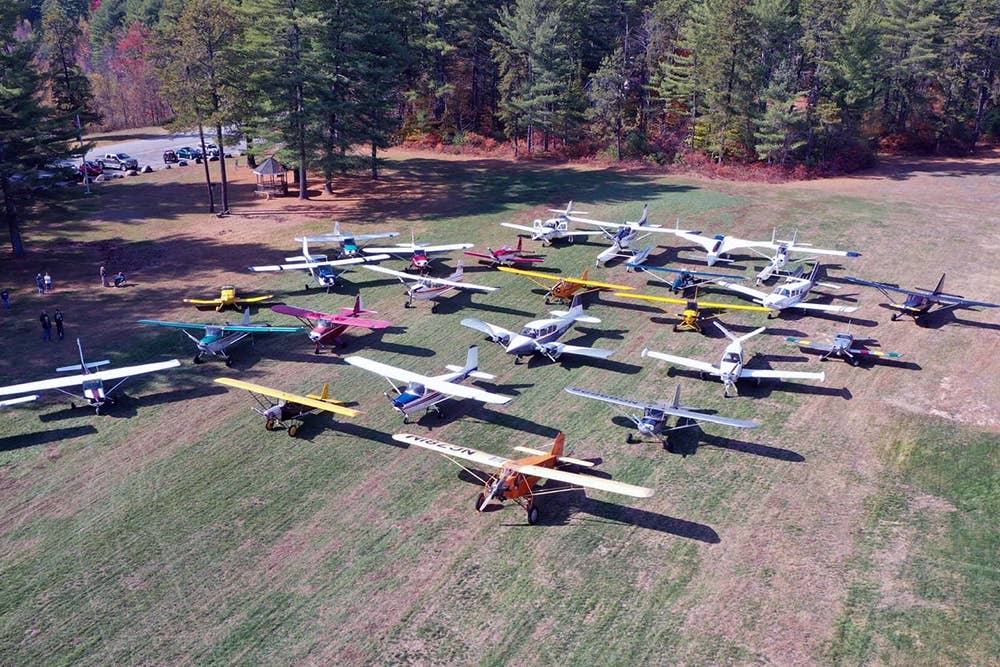In New Hampshire, Two Airpark Communities Work as One
Windsock Village Air Park combines not only two properties, but many different types of aircraft and owners.

A collection of airplanes based at Windsock Village Air Park. [Courtesy: Windsock Village Air Park]
One of Carl Tyler’s main criteria during his most recent home search was a reliable internet connection. Now a resident of West Ossipee, New Hampshire, he ultimately decided upon Windsock Village Air Park (NH69) as his next home base.
When asked whether onfield residents are all born and raised New Englanders, Tyler said, “We have people [living here] from all over the States, really. I’m not even from the States, I’m from England, originally. When I moved here, though, I was living in Boston and had started working from home, like 15-odd years ago. So, wherever there was an internet connection, I could live.
“Then I discovered here, and I asked, ‘So what is the internet connection like up there?’ Once I found that it is OK, I said, ‘OK, I might try moving there!’”
Aside from being a place where the experienced tech entrepreneur was able to reliably work remotely, Windsock Village Air Park checked other boxes that he was concerned about. Namely, the established community was a place where aircraft of all types (up to 12,500 pounds) were not only allowed, but strongly encouraged.
In many regards, NH69 is not unlike many other airparks. But if one digs deeper into the airport and its history, they will find one aspect that is quite different. The sole turf runway is surrounded by more than one neighborhood of aviators living alongside their aircraft.
“We’re an aviation community that consists of two housing associations, but one single aviation corporation. So basically, one side of the runway is what’s known as Soaring Heights and the other side of the runway is Windsock. And they both together form Windsock Village,” Tyler explained.
“The original person that started the whole thing sold off the land on the other side of the runway to somebody else. It started out with the Windsock side first and was built in two phases.
“Basically, we have a grass runway that’s 4,000 feet that we do have lights on,” Tyler said, “so you can fly in here at night. Although, some people prefer not to because we have tall trees all around the airfield. We have approximately 150 to 160 homes in total, but not all of those properties have aviation rights.”
Both associations—as well as their residents and representatives—work in unison to ensure continued use of the airstrip and aspects related to the ongoing concern for the neighborhoods sharing the runway.
One of the ways that residents from both sides showcase their continued efforts is through fly-ins, which Tyler said they strive to hold each year. These anticipated events bring aviators from near and far, with the 2022 date slated for August 20.
Outside of that event and other more informal ones—such as live music events in a resident’s hangar or barbecues—the overall community (both neighborhoods) at NH69 is very aviation-minded on normal days as well.
“There’s lots of active pilots for some of the big airlines that live here that will drive down to Boston when they are flying,” Tyler said. “There are a couple of flight attendants that live here, a lot of retired military pilots, and civil aviation pilots. So, it’s a good mix and all sorts of planes are kept here. We have everything from a Stearman, Cherokee 6’s, RV’s, your usual kind of mish mash of things, including a few twins…and a few people have floats.”
Aside from hosting a variety of fixed-wing aircraft during the summer and other warmer times of the year, the airport is a landing site for an aircraft conversion type rarely seen in more southern areas of the country. And in a way, skiplanes at Windsock Village Air Park are a nod to the town’s past as the birthplace for a heavily utilized transportation method during the cold season.
“We’re located in New Hampshire, just south of the White Mountains, on the edge of the White Mountains, in a town called West Ossipee. The town is famous for being the home of the snowmobile, which was basically a Model T Ford that somebody put tracks on, and skis.”
Even though skiplane operators relish the opportunity to land upon the fresh powder that routinely falls upon the well-maintained north/south runway at Windsock, the landing site is eventually cleared of snow each time the flakes fall.
“But we do plow the runway in the winter, so it stays usable, and we are still active then,” Tyler said. “We tend to have a couple of weeks at the beginning where we are just waiting for the snow and ice to firm up and then we have a couple of weeks in the spring, what we call ‘mud season.’
“Our soil here is basically 12 to 15 feet of sand. So, what happens is we will get a frost underneath the ground, which freezes, and then it just takes a couple of weeks for that to thaw. And then all of the water disappears because it goes straight through [the sand] to the aquifer.”
Whether it be summer or winter, spring or fall, Windsock Village Air Park is a welcoming aviation community with a unique structure that combines two neighborhoods—and one runway.

Sign-up for newsletters & special offers!
Get the latest FLYING stories & special offers delivered directly to your inbox






